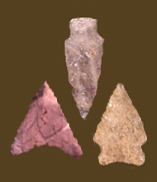
|
GUILFORD
The Guilford point dates to the latter part of the Middle Archaic period, but there is not a lot of supporting data. McAvoy and McAvoy (1997) place it at 6200 to 5500 BP (approximately 5250-4350 BC in calendar years), based on stratigraphic positioning, and suggest the shouldered form may have existed as late as 5000 BP (3800 BC), based on a radiocarbon date from a possible Guilford feature at Cactus Hill, Virginia. Steponaitis (1980) assigns a narrower range of 6200 to 6000 BP (5250-4850 BC). Based on radiocarbon dates obtained in North Carolina at the Gaston site, Coe (1964) indirectly dates this point to at least 6000 BP (4850 BC). Description Blade: The blade is long and narrow, with slightly rounded and smoothly contoured sides. It is usually thick, but symmetrically and carefully chipped. Haft Element: Most examples have a precisely-shaped concave or rounded base; straight bases are rare. Basal margins are often ground. Slight shoulders sometimes occur above the base. Size: Length ranges from 50 to 120 mm, with an average of 90 mm. Width ranges from 20 to 35 mm, with an average of 30 mm. Thickness ranges from 5 to 12 mm. Technique of manufacture: Coe’s (1964) discussion of Guilford point manufacture was based on discarded and partly-finished specimens found at the Doerschuk site in North Carolina. First, a long, thin flake was struck from a prepared flat platform, followed by direct percussion used to roughly shape the point. This percussion was undertaken on one edge at a time for the full length of the specimen, with the base being shaped before starting down the final edge. The third step consisted of retouching the edges by pressure flaking, resulting in a general reduction in width, but not thickness. The final step was grinding the basal edges of the points. Material: In a sample of 138 Guilford points from the lower Patuxent drainage, Steponaitis (1980) reported that 97% were quartzite, followed by quartz (2%), and chert (1%). In the area surrounding Zekiah Swamp on the lower Potomac, Wanser (1982) found that 90% of 49 points were quartzite, with 6% rhyolite, 2% quartz, and small numbers of other materials. In the Monocacy River drainage, 85% of 59 Guilfords were rhyolite, while 10% were quartzite and 5% quartz (Kavanagh 1982). In the middle Potomac Valley, rhyolite and quartzite predominate (Hranicky 2002). Discussion Defined in Literature Coe first published a brief description of the Guilford type in 1952, and expanded this in 1964, based on points recovered from the Doerschuk and Gaston sites in North Carolina. References |
![]()
Search by Shape:
(See Projectile Point Typology) |

|
Thank you for visiting our website. If you have any
questions, comments, Copyright © 2002 by |

|

 Defining Attributes
Defining Attributes